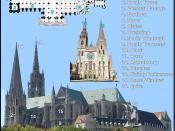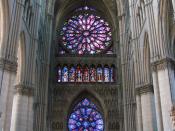Erwin Panofsky's Gothic Architecture and Scholasticism presents a compelling connection between the architectural styles of Gothic Cathedrals and the order and form of the Scholastic school of thought. Focusing on the "100 mile zone around Paris" during the years between 1130-40 and 1270 where and when Scholasticism was the dominate theory of education and Gothic architecture began to take a stronghold over the ageing Romanesque style. In Panofsky's own words "A connection between Gothic art and Scholasticism which is more concrete than a mere "parallelism"â¦the connection which I have in mind is a genuine cause-and-effect relation." But is there a more meaningful conviction that Panofsky is trying to present by explaining this "cause and effect"? Before diving deeper into Panofsky's theory, the terms Scholasticism and Gothic Architecture need to be defined.
Scholasticism is a method of learning taught by the academics of medieval universities from the 11th until the 15th century, originating in Paris.
This method of learning was based on dialectical reasoning, with the purpose of answering a question or settling a disagreement through the use of the Scholastic method. The Scholastic method would compare two or more writings of a related source. The sources would be read aloud to a class of pupils or academics to point of the contradictions between the texts. Then through a series of dialectics focusing on philological and or logical (commonly Aristotelian logic after the Second Crusade circa 1149) analysis the two sides of the contradiction would be interoperated to essentially agree with each other.
Gothic Architecture is a style of architecture originating near Paris with the construction of the abbey church of Saint-Denis. The gothic style flourished during the High and Late Medieval periods. Classic features found in gothic architecture include thin columns and surrounding walls supported by flying buttresses, stained-glass,


